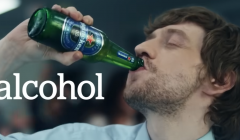
Heineken 0.0 empowers alcohol free drinking without judgement
The ‘0.0 Reasons Needed’ campaign from Publicis Worldwide takes on outdated stigmas associated with alcohol-free options.

Scott Dimbleby strives for a year of embracing fun and humour to offer audiences escapism.

Next year’s creative marketing landscape will feel like a sigh of relief for many—a shift away from the burden of being relentlessly purposeful, to work that lets us breathe, connect, and, dare I say it, even have some fun. For years, brands have leaned heavily on saving the world, layering every campaign with environmental, political, or social purpose. But the reality is, as we stagger through yet another year of permacrisis, people are craving distractions, not reminders.
With threats of nuclear Armageddon, unrelenting climate disasters, and an economy spinning like a washing machine with loose change, 2025 will not be the year to tell consumers to ‘fix themselves’. Instead, we’ll see brands stepping up as the antidote to despair—lifting people out of their anxious doomscrolls, one quirky, hyper-specific campaign at a time.
In a year likely to feel heavier than ever, brands will need to remember something fundamental: creativity can also be escapism.
Scott Dimbleby, Executive Creative Director, W Communications
One of the biggest creative trends for 2025 I believe will be the intentional shrinking of ambition—not in the sense of effort, but in terms of scope. Broad, sweeping campaigns aimed at everyone are fading into the past. Why? Because they don’t resonate in the same way anymore. Instead, brands are increasingly turning to smaller, more targeted communities, aiming for deep impact with the few rather than diluted influence across the many.
Take Nike’s foray into dance and movement culture over the last year as a case in point. Nike isn’t chasing generic athletes with this move; it’s embedding itself within specific communities where dance is not just a performance but a lifestyle. From their collaborations with choreographers like Parris Goebel to campaigns spotlighting dancers from historically underrepresented cultures, they’re cultivating genuine relationships that don’t just sell sneakers—they make the brand part of a wider cultural rhythm.
This approach aligns with how audiences are evolving. Gen Z, now the largest generational demographic in the world, values authenticity and relevance far more than sheer scale. According to a McKinsey report, 58% of Gen Z consumers say they prefer brands that connect with niche communities or micro-cultures rather than trying to appeal to everyone. Brands that successfully target these pockets of culture create superfans, whose loyalty often far outweighs that of a broader, less engaged audience.
In a year likely to feel heavier than ever, brands will need to remember something fundamental: creativity can also be escapism. People don’t want constant reminders of how broken the world is—they want something to smile about, to share, and to anchor them in joy or awe, even briefly.
This doesn’t mean purpose-driven work is dead, but it’s likely to feel far more subtle and woven into the fabric of a brand than overt or didactic. Purpose becomes background radiation rather than the main event—consumers already expect brands to care about the world, but they no longer want to be beaten over the head with it.
Another shift? A newfound reverence for the hyper-local. Just as big cities are increasingly fractured into micro-neighbourhoods with distinct identities, so too are marketing strategies. A brilliant example of this is Airbnb’s recent ‘Made Possible by Hosts’ campaign, which celebrated hosts and neighbourhoods through hyper-specific content targeted to individual cities. Notably, its success came from its precision: it wasn’t just about “travel,” it was about ‘this corner of the world’, curated by someone who knows every cobblestone.
Expect to see more of this in 2025, as brands develop campaigns designed to work less globally but more so on the granular, almost postcode-led level. Research from McKinsey confirms this shift: 76% of consumers say they’re more likely to trust a brand that personalises its outreach and communication based on location and community.
Here’s where things might get really interesting. One of the most radical ideas likely to take hold in 2025 is the rise of AI not just as a ‘tool’ for creativity, but as a ‘collaborator.’ We’re already seeing hints of this in music, with generative AI being used to create new tracks inspired by long-gone artists, or in fashion, where AI models are building on archival designs to create something utterly new.
For marketers, the real opportunity lies in ‘dynamic creativity’ - campaigns that evolve based on real-time data and audience interaction. Imagine a brand building an ad that doesn’t just speak to its audience but shifts with them. A sneaker campaign, for example, could generate different visuals, clever copy lines, and tonality depending on the neighbourhood, the weather, or even the time of day. AI will no longer just support the process; it could well become part of the creative team.
In 2025, marketing creativity will shift from sweeping to specific, from purpose-heavy to joyful, and from static to dynamic. Audiences are tired, overstimulated, and craving something real—whether that’s a genuine connection to their community or a fleeting moment of escapism. The brands that thrive will be the ones that recognise this and act with intention, precision, and just the right amount of irreverence.
Because if there’s one thing we’ll all need next year, it’s this: less doom, more room to breathe—and a reminder that not everything has to be so damn serious.
Scott Dimbleby is Executive Creative Director at agency, W Communications.
Looks like you need to create a Creativebrief account to perform this action.
Create account Sign inLooks like you need to create a Creativebrief account to perform this action.
Create account Sign in